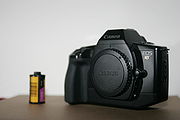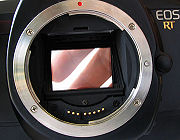
Canon EOS RT
Encyclopedia



135 film
The term 135 was introduced by Kodak in 1934 as a designation for cartridge film wide, specifically for still photography. It quickly grew in popularity, surpassing 120 film by the late 1960s to become the most popular photographic film format...
single-lens reflex
Single-lens reflex camera
A single-lens reflex camera is a camera that typically uses a semi-automatic moving mirror system that permits the photographer to see exactly what will be captured by the film or digital imaging system, as opposed to pre-SLR cameras where the view through the viewfinder could be significantly...
camera
Camera
A camera is a device that records and stores images. These images may be still photographs or moving images such as videos or movies. The term camera comes from the camera obscura , an early mechanism for projecting images...
produced by Canon
Canon Inc.
is a Japanese multinational corporation that specialises in the manufacture of imaging and optical products, including cameras, camcorders, photocopiers, steppers and computer printers. Its headquarters are located in Ōta, Tokyo, Japan.-Origins:...
from 1989 to 1992. The camera is essentially an EOS 630/EOS 600 with a pellicle mirror
Pellicle mirror
right|thumb|The pellicle mirror of the [[Canon EOS RT]]A pellicle mirror is an ultra-thin, ultra-lightweight semi-transparent mirror employed in the light path of an optical instrument, splitting the light beam into two separate beams, both of reduced light intensity...
. It was the first autofocus
Autofocus
An autofocus optical system uses a sensor, a control system and a motor to focus fully automatic or on a manually selected point or area. An electronic rangefinder has a display instead of the motor; the adjustment of the optical system has to be done manually until indication...
camera to feature a pellicle mirror, followed by the EOS 1N RS five years later. Canon had made a few manual focus pellicle mirror SLR bodies previously, including the Pellix
Canon Pellix
In the mid 1960s through the lens exposure metering was the new technology entering the SLR camera market. The Pellix was Canon's answer to that challenge. This technology was first successfully realised in a 35mm SLR camera in the remarkable Tokyo Kogaku KK Topcon RE-Super, launched in 1963, but...
, Pellix QL, and a special limited-production cameras made for professional photographers at the 1972 and 1984 Olympic Games (the F-1
Canon F-1
The Canon F-1 is a 35 mm single-lens reflex camera produced by Canon of Japan from March 1971 until 1976's introduction of the mildly updated F-1n, while in 1981 a New F-1 was launched. The new Canon FD lens mount was introduced along with the F-1, but the previous Canon FL-mount lenses were...
and New F-1
Canon New F-1
The Canon New F-1 replaced the F-1n as Canon's top-of-the-line 35mm single-lens reflex camera in 1981. Like the earlier models, the New F-1 takes FD-mount lenses. Although no date has ever been confirmed, it is thought that the last New F-1 was made in 1992...
High Speed Motor Drive
Motor drive
A motor drive, in the field of photography, is a powered film transport mechanism. Historically, film loading, advancing, and rewinding were all manually driven functions...
models respectively).
Pellicle mirrors offer some of the advantages of a rangefinder camera
Rangefinder camera
A rangefinder camera is a camera fitted with a rangefinder: a range-finding focusing mechanism allowing the photographer to measure the subject distance and take photographs that are in sharp focus...
in an SLR. When taking a picture with a typical SLR camera, the mirror must flip upwards to move out of the way to allow light to pass from the lens to the film plane (or digital image sensor
Image sensor
An image sensor is a device that converts an optical image into an electronic signal. It is used mostly in digital cameras and other imaging devices...
). Moving the mirror produces noise, introduces vibration, and causes the viewfinder to "black out". The camera also must have a slight delay between when the shutter release button is pressed, and when the shutter actually opens to allow time for the mirror to move. Quiet operation, low vibration, absence of blackout, and fast response are features usually associated with rangefinder cameras, as these cameras have no mirror reflex system between the lens and the film.
A pellicle mirror, such as the one in the EOS RT, always reflects some of the light up to the viewfinder, and allows the rest to pass to the film plane. Therefore the mirror does not need to move when a picture is taken. Having an uninterrupted view through the finder is especially helpful when trying to pan the camera and keep moving objects in the viewfinder, or during sports photography. Although the viewfinder does not blackout, it can however go very dim as the lens stops down to the taking aperture, so this advantage is greater at wider apertures.
A disadvantage of a pellicle mirror is that the light diverted to the viewfinder means less light is available to expose the film — in the case of the EOS RT, the lens effectively loses 2/3 of an f-stop. A less reflective mirror might be used, but then the viewfinder would be darker and harder to use. The advantages of a stationary mirror are less important now that modern cameras can move the mirror back and forth very quickly, reducing the shutter release lag and increasing the amount of time the viewfinder is usable. Cameras such as the Canon EOS-1D
Canon EOS-1D
The Canon EOS-1D is a 4-megapixel professional digital single-lens reflex camera launched in November 2001. It was Canon's first professional-level digital camera developed and released by themselves, the previous D2000 being a collaborative effort with Kodak. It has a 1.3x crop factor with a CCD...
Canon EOS-1D Mark II
Canon EOS-1D Mark II
The EOS 1D Mark II is a professional 8.2 megapixel digital single lens reflex camera camera body produced by Canon. The EOS 1D Mark II is the successor of the EOS 1D.-Features:The EOS 1D Mark II features:* 28.7 × 19.1 mm CMOS sensor...
are able to take 8+ frames per second while moving the mirror back and forth, which is very close to the 10 frame per second rate of the pellicle mirror-equipped 1N RS. The EOS-1v
Canon EOS-1v
The Canon EOS-1v is a 35mm single-lens reflex camera from Canon's EOS series, released in 2000, it is the final film camera in Canon's landmark EOS-1 series of professional cameras...
with PB-E2 power booster (2000 release) and the recent EOS-1D Mark III
Canon EOS-1D Mark III
The EOS 1D Mark III is a professional 10.1 megapixel digital single lens reflex camera camera body produced by Canon. The EOS 1D Mark III was announced on February 21, 2007 and is the successor of the Canon EOS-1D Mark II N and was first released in May 2007...
are capable of sustaining 10 frames per second burst rates without the use of a pellicle mirror. Finally, the pellicle mirror does degrade lens resolution, as early tests performed in Modern Photography magazine have shown that the Canon film counterparts produce sharper images than those Canon camera bodies that have a pellicle mirror.

